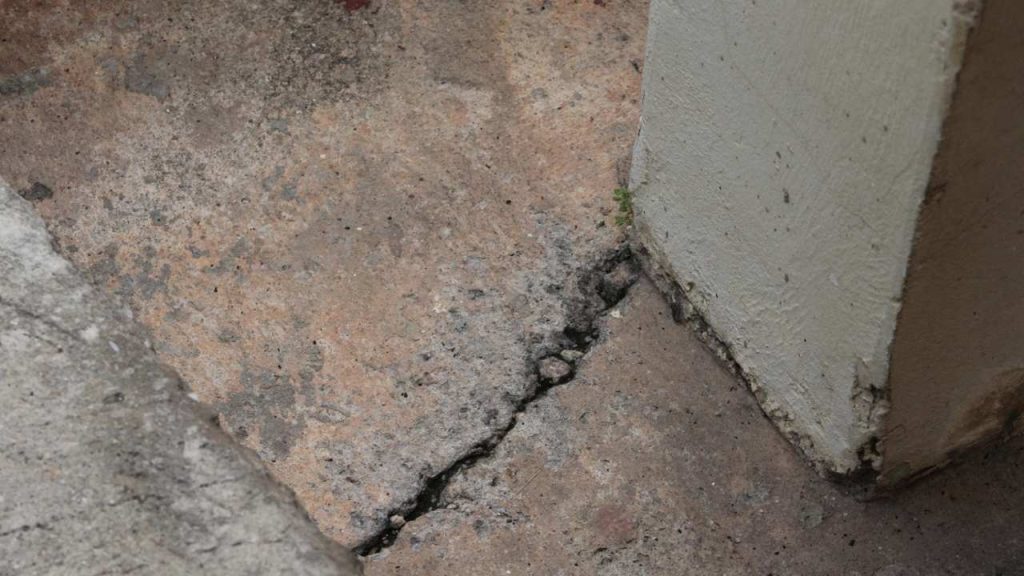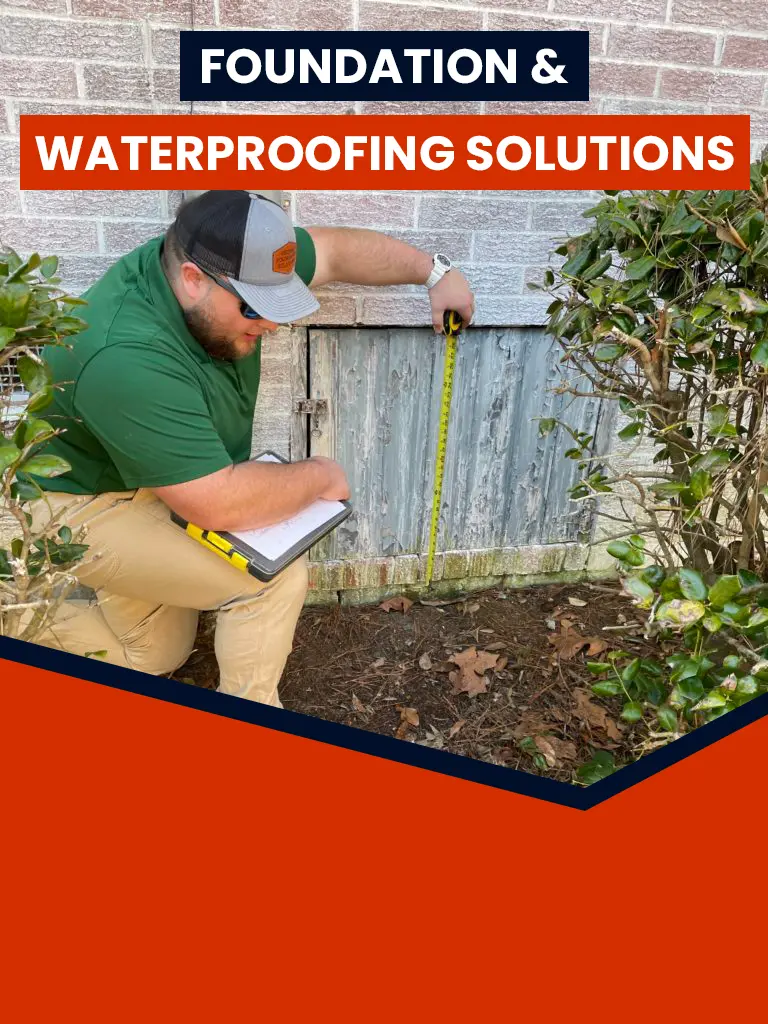Homes with basements provide valuable extra living or storage space, but they are also susceptible to unique basement foundation issues. Since basements are located below ground level, they face increased exposure to soil pressure, water intrusion, and settling. These factors can lead to serious basement foundation issues if not addressed promptly. Regions with heavy rainfall, clay-rich soil, or fluctuating temperatures are particularly prone to these challenges.
In this article, we’ll explore common basement foundation issues, such as water intrusion, foundation cracks, and bowing walls, along with practical solutions to help homeowners protect their homes and prevent costly repairs.
1. Water Intrusion and Moisture Problems
Where it’s found:
One of the most common issues for homes with basements is water intrusion. Because basements are located below ground, they are more vulnerable to groundwater seepage, especially in areas with heavy rainfall or poor drainage. Water can find its way into the basement through cracks in the foundation walls or floor, causing a variety of problems, such as:
- Basement flooding: Heavy rains or a high water table can lead to flooding in the basement, which may damage the foundation, flooring, and any belongings stored there.
- Mold and mildew: Excess moisture in the basement can lead to the growth of mold and mildew, which not only damages your home but can also pose health risks.
- Musty odors: Even if water doesn’t flood the basement, high humidity levels can lead to musty smells and air quality issues in your home.
How to address it:
- Install a sump pump: A sump pump can help remove water from the basement before it has a chance to cause damage.
- Improve drainage: Ensure proper grading around the home to direct water away from the foundation, and clean gutters and downspouts regularly to prevent overflow.
- Seal cracks: Sealing any cracks in the walls or floor with waterproof sealant can prevent water from seeping into the basement.
2. Foundation Cracks
Cracks in the foundation walls or floors are a common issue in basement homes. These cracks can occur due to several factors, including settling of the home, soil pressure, or water damage. While small hairline cracks are often harmless, larger cracks can be a sign of more serious foundation problems.

Types of foundation cracks:
Sandy soil is loose, drains quickly, and lacks the ability to retain water effectively. While this makes it less prone to expansion compared to clay-rich soils, it can still contribute to basement foundation issues such as erosion and soil shifting. These problems can destabilize the foundation over time, leading to cracks, uneven settling, or other structural concerns. Addressing basement foundation issues in homes built on sandy soil requires proactive measures like improving drainage, reinforcing the foundation, and stabilizing the soil to prevent long-term damage. Proper maintenance is key to minimizing the risks associated with sandy soil and basement foundation issues.
- Horizontal cracks: These are often caused by pressure from the soil outside the basement walls. As the soil expands and contracts with changes in moisture levels, it can push against the walls, causing them to crack. Horizontal cracks can be particularly serious and may indicate that the walls are bowing or at risk of collapsing.
- Vertical cracks: These are often caused by settling or shrinkage of the foundation. While smaller vertical cracks are generally less serious, they can still allow water to seep into the basement.
- Stair-step cracks: These cracks follow the mortar lines in block or brick foundations and can be a sign of differential settling, where one part of the foundation settles more than another.
How to address it:
- Epoxy injection: For smaller cracks, epoxy injection can seal the crack and restore the structural integrity of the foundation.
- Wall anchors or braces: If horizontal cracks are caused by bowing walls, installing wall anchors or braces can help stabilize the walls and prevent further movement.
- Consult a foundation expert: If you notice large or widening cracks, it’s best to consult a professional to assess the situation and recommend repairs.
3. Bowing or Leaning Walls
Bowing or leaning basement walls are a serious issue that can compromise the structural integrity of your home. This problem is typically caused by excessive pressure from the soil outside the basement. When the soil around the foundation becomes saturated with water, it expands and pushes against the basement walls, causing them to bow inward.
Signs of bowing walls:
- Horizontal cracks that widen over time
- Visible inward bowing or leaning of the walls
- Water stains or dampness along the walls
How to address it:
- Wall anchors: Wall anchors can be installed to stabilize the walls and pull them back into their original position. This is a long-term solution that can prevent further bowing.
- Carbon fiber straps: In less severe cases, carbon fiber straps can be applied to the walls to reinforce them and prevent additional movement.
- Drainage improvements: Addressing drainage issues around the home can help reduce the pressure on the walls by preventing water from saturating the soil.
4. Foundation Settling or Sinking
- Cracks in walls and ceilings
- Uneven floors
- Doors and windows that don’t close properly
How to address it:
- Helical piers: One of the most effective ways to address foundation settling is by installing helical piers. These steel piers are driven deep into the ground to reach stable soil, lifting and stabilizing the foundation.
- Slab jacking: For homes with concrete slabs, slab jacking (or mudjacking) can be used to lift the foundation back into place by injecting a grout mixture beneath the slab.
- Soil stabilization: In some cases, stabilizing the soil around the foundation by improving drainage or adding a soil treatment can help prevent further settling.
5. Poor Drainage and Hydrostatic Pressure
Inadequate drainage around a home is a common cause of basement foundation issues, particularly in homes with basements. When water is not effectively directed away from the foundation, it can lead to hydrostatic pressure—an excessive buildup of water in the surrounding soil that pushes against basement walls and floors. This pressure can result in significant basement foundation issues, including cracks, bowing walls, and water intrusion. Over time, if not addressed, these basement foundation issues can compromise the structural integrity of the home and lead to costly repairs. Proper drainage solutions are essential to prevent these problems.
How to address it:
- Install French drains: A French drain is a trench filled with gravel and a perforated pipe that helps direct water away from the foundation, reducing hydrostatic pressure.
- Gutter maintenance: Keeping your gutters and downspouts clean and functional will ensure that water is directed away from the foundation rather than pooling around it.
- Regrade the soil: The soil around your home should slope away from the foundation to prevent water from accumulating near the basement.
6. High Humidity and Ventilation Issues in Basement Foundation Issues
Basements in homes with basement foundation issues often face high humidity levels due to limited ventilation and their below-ground location. Poor air circulation can trap moisture in the basement, exacerbating problems like mold, mildew, and musty odors. This is particularly common in humid climates or homes with inadequate HVAC systems.
Signs of high humidity:
- Condensation on walls or windows
- Persistent musty odors
- Mold or mildew growth in corners or along walls
- Damp or sticky air
How to address it:
- Dehumidifiers: Installing a basement dehumidifier can help control moisture levels and improve air quality.
- Improve ventilation: Adding vents or connecting the basement to the home’s HVAC system can enhance airflow and reduce humidity.
- Moisture barriers: Applying moisture-resistant paint or installing vapor barriers can help prevent moisture from seeping into the basement walls and floor.
- Regular maintenance: Keep an eye on any signs of water intrusion, such as cracks or leaks, and address them promptly to maintain a dry and ventilated environment.
Conclusion
Homes with basements offer numerous advantages, but they are also prone to several basement foundation issues that can impact the stability and safety of the home. Common problems include water intrusion, foundation cracks, bowing walls, and settling, all of which can compromise the structural integrity of your property. These basement foundation issues often arise due to factors like poor drainage, soil pressure, and fluctuating moisture levels.
Fortunately, addressing basement foundation issues through proper drainage systems, sealing cracks, and implementing solutions like helical piers or wall anchors can help homeowners protect their homes and prevent costly repairs. Taking proactive measures is key to ensuring a long-lasting and stable foundation.
If you’re dealing with any basement foundation issues, consulting a foundation expert is essential. A professional assessment can help identify the root cause of the problem and provide tailored solutions to safeguard your home for years to come.

